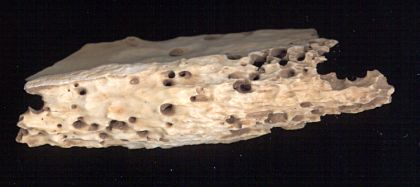

Bones are amazing things. Paleontologists can identify an animal from fossil bones, and forensic scientists can determine the age and sex from human remains. Arthritis and fractured bones are obvious. Still, few people realize the extent to which old bones can tell a tale. For example, stresses resulting in temporary pauses of growth during childhood, such as caused by malnutrition, appear in x-ray photos as so-called Harris lines. This is of interest not only to archaeologists ferreting out the conditions of life in the past, but to paleontologists trying to determine if animals such as mastodons became extinct because of inadequate diets or disease.
Bones during life remold themselves according to the physical stresses
placed on them. Long hours spent kneeling before a metate, grinding corn, reveal
themselves in changes in the knee and toe areas, and carrying heavy loads affects
muscle attachments. Sometimes, bones even reveal the fate of their owners. A 4-inch
fossil fragment from the northern Chihuahuan Desert, for example, is heavily
pitted—prime evidence of dwelling in the stomach of a large carnivore!

Contributor: Arthur H. Harris, Laboratory for Environmental Biology, Centennial Museum, University of Texas at El Paso.
Desert Diary is a joint production of the Centennial Museum and KTEP National Public Radio at the University of Texas at El Paso.

A fragmentary, fossil mammal bone that has passed through the digestive system of a large carnivore. The bone is approximately 4" long. Digestive acid has eroded the surface and canals that allowed the acid into the interior of the bone material. Scanned specimen from Dry Cave, Eddy Co., NM.